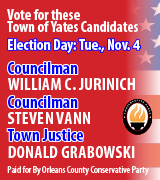750-mile Empire State Trail complete, making nation’s longest multi-use state trail

Photo by Tom Rivers: The Erie Canal towpath which is part of the Empire State Trail is shown today in Eagle Harbor near the lift bridge.
Press Release, Gov. Andrew Cuomo’s Office
Governor Andrew M. Cuomo today announced completion of the Empire State Trail, now the nation’s longest multi-use state trail, which will be fully open on December 31.
The trail spans 750-miles total, 75 percent of which is off-road trails ideal for cyclists, hikers, runners, cross-country skiers and snow-shoers. The new recreational trail, which runs from New York City through the Hudson and Champlain Valleys to Canada, and from Albany to Buffalo along the Erie Canal, will provide a safe and scenic pathway for New Yorkers and tourists to experience New York State’s varied landscapes. The Empire State Trail is expected to draw 8.6 million residents and tourists annually.
“Nearly four years ago, we announced plans to build the Empire State Trail and I am excited to announce it’s been completed on time and will open on New Year’s Eve,” Governor Cuomo said. “There’s no trail like it in the nation – 750 miles of multi-use trail literally from Manhattan to the Canadian Border, from Buffalo to Albany. Not only does it provide an opportunity to experience the natural beauty and history of New York, but it also gives New Yorkers from every corner of the state a safe outlet for recreation as we continue to grapple with the Covid-19 pandemic. As we approach the holiday weekend, there is no better time than now to put on your mask and experience it for yourself.”
Introduced in the Governor’s 2017 State of the State address, the Empire State Trail will be open year-round, including winter. It connects 20 regional trails to create a continuous statewide signed route. As part of the 58 distinct projects to complete the Trail on time, more than 180 miles of new off-road trail was created and 400 miles of previously disconnected, off-road trails were linked to eliminate gaps and ease engineering challenges such as railroad and water crossings in high traffic areas.
The New York State Department of Transportation improved 170 miles of on-road bicycle route sections to enhance safety and travel on low-speed rural roadways and city streets when possible. New York State also installed 45 gateways and trailheads along the route to welcome visitors and branded the trail with signage, interpretive panels, bike racks, and benches.
The Empire State Trail website provides quick and easy access to trail information including segment descriptions, access points, trail distances, parking areas, restrooms, and nearby amenities and attractions.
The website’s responsive and user-friendly design allows users to access interactive maps from mobile devices, zoom in to specific location of interest, and download/print maps of trail segments. Cyclists can print “cue sheets” with highly detailed directions for following a selected trail segment. The site also features information about the variety of activities and destinations on or near the trail such as campgrounds, parks, historic sites, and popular stops among the local communities.
Recently completed projects that finalize the trail include:
Hudson Valley
- Albany-Hudson Electric Trail: The Hudson River Valley Greenway constructed 36 miles of off-road and on road trails from the city of Rensselaer to the City of Hudson in Rensselaer and Columbia counties. The $45 million trail follows the historic route of an electric trolley which operated from 1900 to 1929. The corridor is owned by National Grid, which authorized New York State to build a trail on the route.
- Maybrook Trailway: Metro-North Railroad constructed a new 23-mile rail-trail on its inactive “Beacon Line” corridor from Hopewell Junction in Dutchess County to Brewster in Putnam County passing through the towns of Pawling, Southeast, Paterson, Beekman and East Fishkill. Along the route, the trail winds through rural landscapes and wooded areas featuring seasonal waterfalls and crosses the Appalachian Trail. The $42 million Beacon Line was the first all-rail freight connection across the Hudson River north of New York City. It originally opened as a rail line in 1892 and served as a vital transportation link between New York and southern New England, carrying trains between Derby Junction and Maybrook, via the bridge over the Hudson River at Poughkeepsie that is now the Walkway Over the Hudson.
- Hudson River Brickyard Trail: The City of Kingston constructed a new 1.5-mile Empire State Trail section along the Hudson River shoreline. The $1.4 million project was built with City of Kingston and Town of Ulster funds matched by state grants from the Department of State and Hudson River Valley Greenway.
- Battery Park City Gateway: The $450,000 gateway marks the southern terminus of the trail in Lower Manhattan.
Erie Canalway Trail
- The Ralph C. Wilson Jr. Gateways: These four gateways in Western New York provide a welcoming connection for trail visitors at key access points in: Buffalo Harbor State Park in Buffalo; at the western entrance to the Erie Canal in Tonawanda; at Five Locks Park in Lockport; and in Genesee Valley Park in Rochester. The gateways include kiosks featuring local and statewide trail information, bicycle racks, and shaded granite block seating. Each gateway features a “Ralph C. Wilson, Jr.” memorial plaque honoring the late owner of the Buffalo Bills. The Ralph C. Wilson, Jr. Foundation provided $2.6 million dollars for the gateways.
- Macedon Bridge: NYSDOT restored a closed vehicle bridge over the Erie Canal. The $4.2 million investment created a bicycling and walking trail and created a local park.
- Erie Blvd-Syracuse: NYSDOT constructed a 3-mile trail in the median of Erie Blvd, from East Syracuse to DeWitt. The project cost $23 million.
- Loop the Lake Trail-Syracuse: Onondaga County constructed a new 1.5-mile trail on the south shore of Onondaga Lake, including a new bicycle/pedestrian bridge over CSX’s rail line. The project was funded with County and federal funds.
- Utica: New York State Canal Corporation constructed a new 3.5-mile trail east of Utica for $9.3 million
- Herkimer County: New York State Canal Corporation completed a new 2.2-mile trail section Lock E18 to Route 167, a new 1.3-mile trail section Frankfort to Ilion, and a new 2-mile trail from Ilion to Mohawk. These projects totaled $16.4 million.
Champlain Canalway
- Fort Edward to Fort Ann: The New York State Canal Corporation constructed two adjacent trail sections. The $14.3 million investment created a 12-mile trail from Fort Edward to Fort Ann.
- Fort Ann to Comstock: NYSDOT built a new 0.75-mile off-road trail in Washington County and designated a 7-mile route on local roads and cost $2 million.
New York State Parks Commissioner Erik Kulleseid said, “The Empire State Trail is a testament to Governor Cuomo’s vision to make New York State an unmatched destination for outdoor recreation. Everyone from the most experienced long-distance cyclists to family groups with children will enjoy this pathway. People can take a quick bike ride or walk close to home, or they can plan a multi-day adventure to take them from one end of the state to the other.”
New York State Canal Corporation Director Brian U. Stratton said, “Governor Cuomo’s vision for the newly-completed Empire State Trail merges economic development with the beautiful views along the Canal system to create exceptional outdoor recreation opportunities, both for residents of canalside communities and for visitors from across New York and beyond. The Erie Canalway and Champlain Canalway Trail segments of the Empire State Trail reintroduce New Yorkers to the historic towpaths of our state’s storied waterways and connect a new generation to the rich heritage of the New York Canal system.”






































































